Comprehensive Care Plan for Multiple Sclerosis: Curtin Hospital Case
VerifiedAdded on 2023/06/03
|14
|3226
|151
Case Study
AI Summary
This assignment presents a comprehensive care plan for Heather Cook, a 48-year-old female diagnosed with multiple sclerosis, admitted to Curtin Hospital for a Stage 1 pressure injury. The care plan addresses four key nursing diagnostic statements: risk for fatigue, risk for acute pain, risk for impaire...

Running head: CARE PLAN FOR MULTIPLE SCLEROSIS
CARE PLAN FOR MULTIPLE SCLEROSIS
Name of the Student
Name of the University
Author Note:
CARE PLAN FOR MULTIPLE SCLEROSIS
Name of the Student
Name of the University
Author Note:
Paraphrase This Document
Need a fresh take? Get an instant paraphrase of this document with our AI Paraphraser
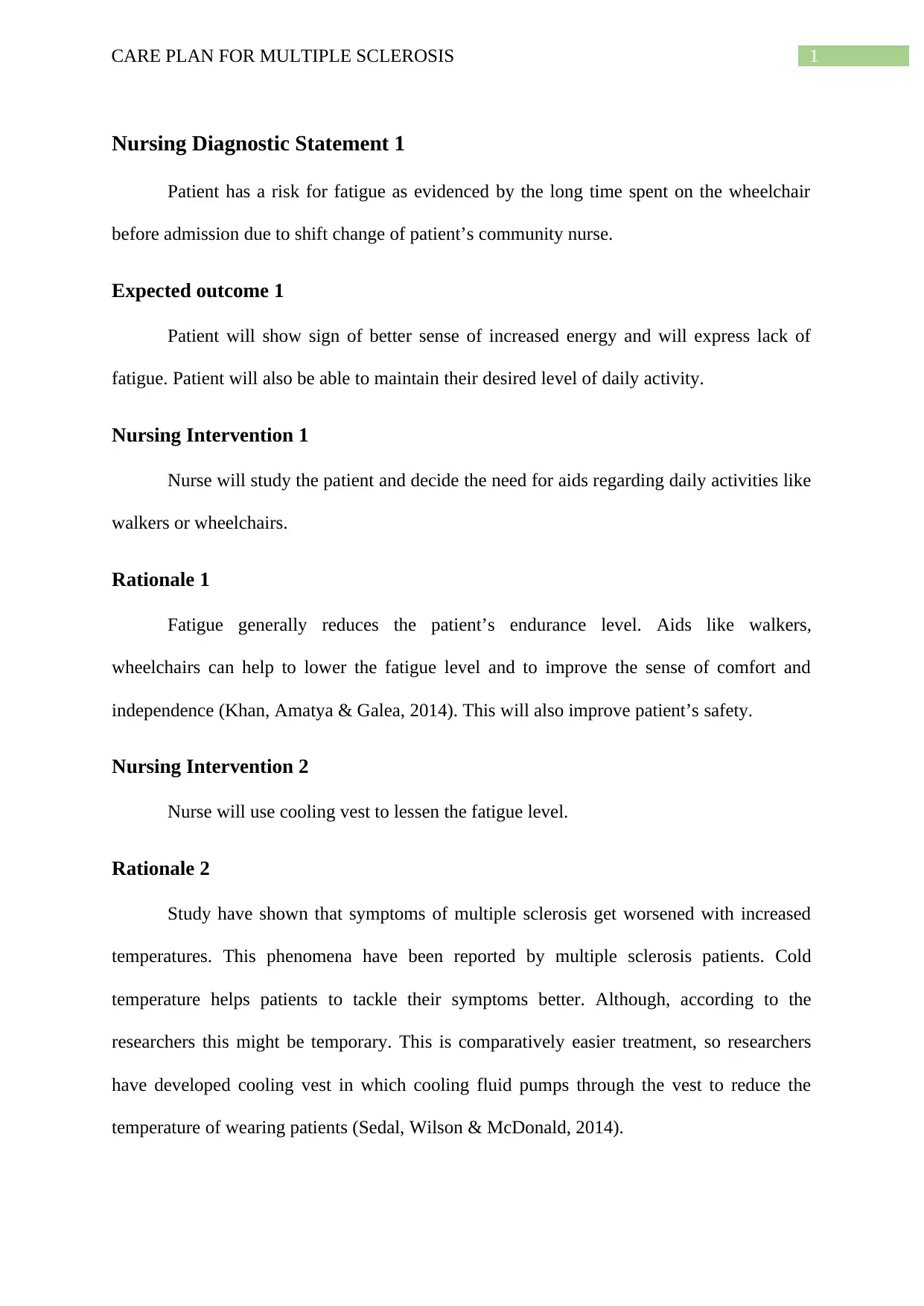
1CARE PLAN FOR MULTIPLE SCLEROSIS
Nursing Diagnostic Statement 1
Patient has a risk for fatigue as evidenced by the long time spent on the wheelchair
before admission due to shift change of patient’s community nurse.
Expected outcome 1
Patient will show sign of better sense of increased energy and will express lack of
fatigue. Patient will also be able to maintain their desired level of daily activity.
Nursing Intervention 1
Nurse will study the patient and decide the need for aids regarding daily activities like
walkers or wheelchairs.
Rationale 1
Fatigue generally reduces the patient’s endurance level. Aids like walkers,
wheelchairs can help to lower the fatigue level and to improve the sense of comfort and
independence (Khan, Amatya & Galea, 2014). This will also improve patient’s safety.
Nursing Intervention 2
Nurse will use cooling vest to lessen the fatigue level.
Rationale 2
Study have shown that symptoms of multiple sclerosis get worsened with increased
temperatures. This phenomena have been reported by multiple sclerosis patients. Cold
temperature helps patients to tackle their symptoms better. Although, according to the
researchers this might be temporary. This is comparatively easier treatment, so researchers
have developed cooling vest in which cooling fluid pumps through the vest to reduce the
temperature of wearing patients (Sedal, Wilson & McDonald, 2014).
Nursing Diagnostic Statement 1
Patient has a risk for fatigue as evidenced by the long time spent on the wheelchair
before admission due to shift change of patient’s community nurse.
Expected outcome 1
Patient will show sign of better sense of increased energy and will express lack of
fatigue. Patient will also be able to maintain their desired level of daily activity.
Nursing Intervention 1
Nurse will study the patient and decide the need for aids regarding daily activities like
walkers or wheelchairs.
Rationale 1
Fatigue generally reduces the patient’s endurance level. Aids like walkers,
wheelchairs can help to lower the fatigue level and to improve the sense of comfort and
independence (Khan, Amatya & Galea, 2014). This will also improve patient’s safety.
Nursing Intervention 2
Nurse will use cooling vest to lessen the fatigue level.
Rationale 2
Study have shown that symptoms of multiple sclerosis get worsened with increased
temperatures. This phenomena have been reported by multiple sclerosis patients. Cold
temperature helps patients to tackle their symptoms better. Although, according to the
researchers this might be temporary. This is comparatively easier treatment, so researchers
have developed cooling vest in which cooling fluid pumps through the vest to reduce the
temperature of wearing patients (Sedal, Wilson & McDonald, 2014).
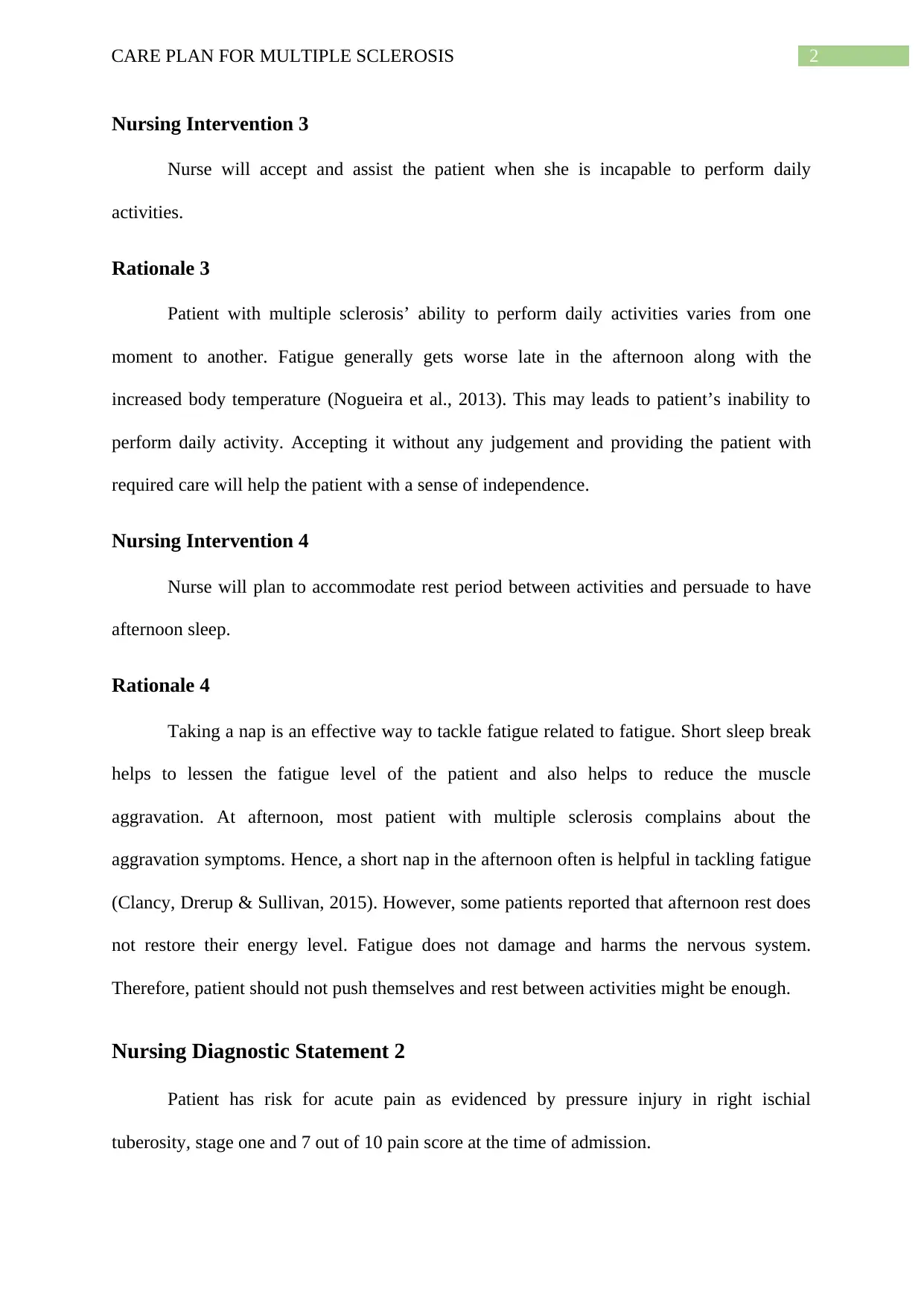
2CARE PLAN FOR MULTIPLE SCLEROSIS
Nursing Intervention 3
Nurse will accept and assist the patient when she is incapable to perform daily
activities.
Rationale 3
Patient with multiple sclerosis’ ability to perform daily activities varies from one
moment to another. Fatigue generally gets worse late in the afternoon along with the
increased body temperature (Nogueira et al., 2013). This may leads to patient’s inability to
perform daily activity. Accepting it without any judgement and providing the patient with
required care will help the patient with a sense of independence.
Nursing Intervention 4
Nurse will plan to accommodate rest period between activities and persuade to have
afternoon sleep.
Rationale 4
Taking a nap is an effective way to tackle fatigue related to fatigue. Short sleep break
helps to lessen the fatigue level of the patient and also helps to reduce the muscle
aggravation. At afternoon, most patient with multiple sclerosis complains about the
aggravation symptoms. Hence, a short nap in the afternoon often is helpful in tackling fatigue
(Clancy, Drerup & Sullivan, 2015). However, some patients reported that afternoon rest does
not restore their energy level. Fatigue does not damage and harms the nervous system.
Therefore, patient should not push themselves and rest between activities might be enough.
Nursing Diagnostic Statement 2
Patient has risk for acute pain as evidenced by pressure injury in right ischial
tuberosity, stage one and 7 out of 10 pain score at the time of admission.
Nursing Intervention 3
Nurse will accept and assist the patient when she is incapable to perform daily
activities.
Rationale 3
Patient with multiple sclerosis’ ability to perform daily activities varies from one
moment to another. Fatigue generally gets worse late in the afternoon along with the
increased body temperature (Nogueira et al., 2013). This may leads to patient’s inability to
perform daily activity. Accepting it without any judgement and providing the patient with
required care will help the patient with a sense of independence.
Nursing Intervention 4
Nurse will plan to accommodate rest period between activities and persuade to have
afternoon sleep.
Rationale 4
Taking a nap is an effective way to tackle fatigue related to fatigue. Short sleep break
helps to lessen the fatigue level of the patient and also helps to reduce the muscle
aggravation. At afternoon, most patient with multiple sclerosis complains about the
aggravation symptoms. Hence, a short nap in the afternoon often is helpful in tackling fatigue
(Clancy, Drerup & Sullivan, 2015). However, some patients reported that afternoon rest does
not restore their energy level. Fatigue does not damage and harms the nervous system.
Therefore, patient should not push themselves and rest between activities might be enough.
Nursing Diagnostic Statement 2
Patient has risk for acute pain as evidenced by pressure injury in right ischial
tuberosity, stage one and 7 out of 10 pain score at the time of admission.
⊘ This is a preview!⊘
Do you want full access?
Subscribe today to unlock all pages.

Trusted by 1+ million students worldwide
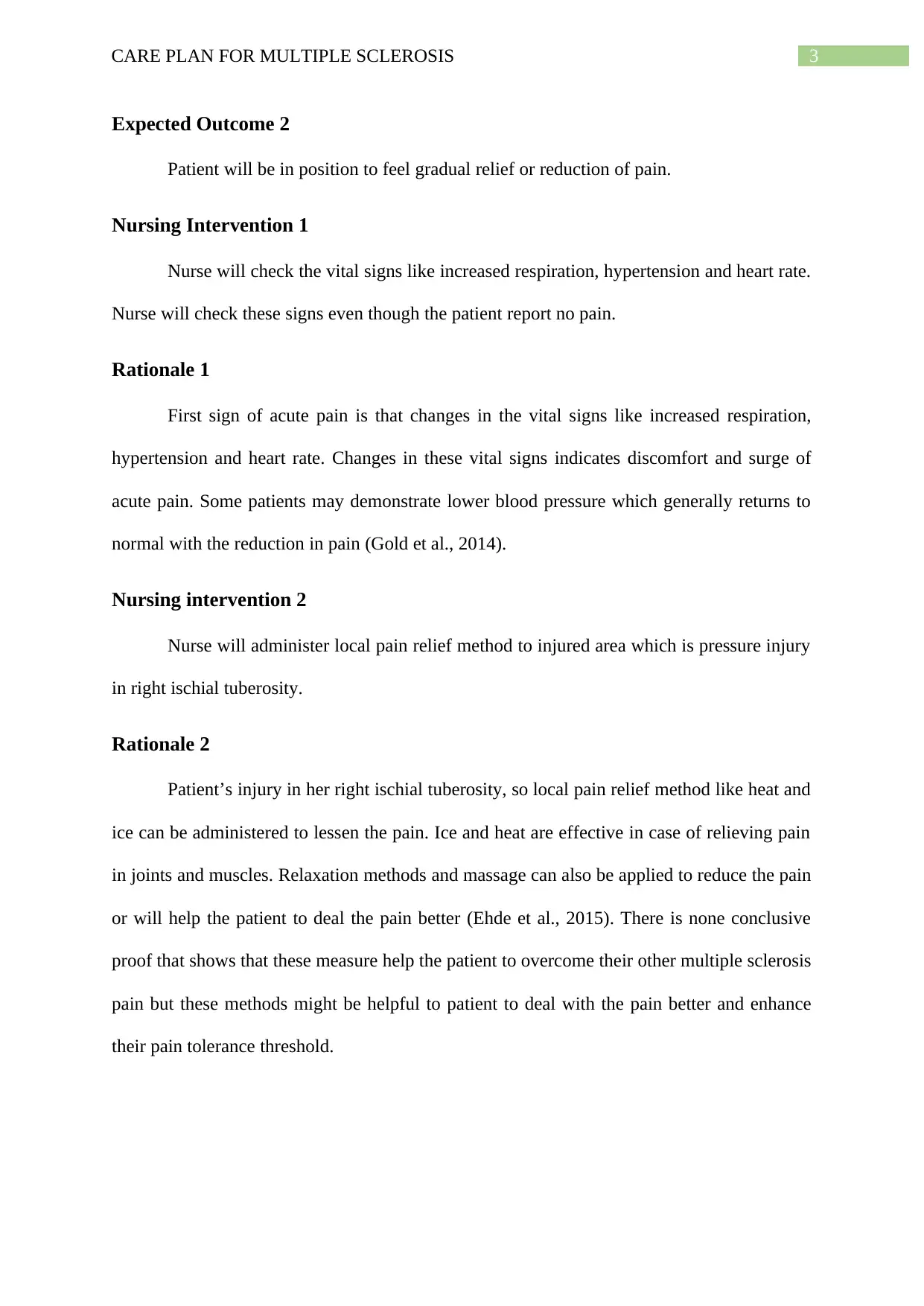
3CARE PLAN FOR MULTIPLE SCLEROSIS
Expected Outcome 2
Patient will be in position to feel gradual relief or reduction of pain.
Nursing Intervention 1
Nurse will check the vital signs like increased respiration, hypertension and heart rate.
Nurse will check these signs even though the patient report no pain.
Rationale 1
First sign of acute pain is that changes in the vital signs like increased respiration,
hypertension and heart rate. Changes in these vital signs indicates discomfort and surge of
acute pain. Some patients may demonstrate lower blood pressure which generally returns to
normal with the reduction in pain (Gold et al., 2014).
Nursing intervention 2
Nurse will administer local pain relief method to injured area which is pressure injury
in right ischial tuberosity.
Rationale 2
Patient’s injury in her right ischial tuberosity, so local pain relief method like heat and
ice can be administered to lessen the pain. Ice and heat are effective in case of relieving pain
in joints and muscles. Relaxation methods and massage can also be applied to reduce the pain
or will help the patient to deal the pain better (Ehde et al., 2015). There is none conclusive
proof that shows that these measure help the patient to overcome their other multiple sclerosis
pain but these methods might be helpful to patient to deal with the pain better and enhance
their pain tolerance threshold.
Expected Outcome 2
Patient will be in position to feel gradual relief or reduction of pain.
Nursing Intervention 1
Nurse will check the vital signs like increased respiration, hypertension and heart rate.
Nurse will check these signs even though the patient report no pain.
Rationale 1
First sign of acute pain is that changes in the vital signs like increased respiration,
hypertension and heart rate. Changes in these vital signs indicates discomfort and surge of
acute pain. Some patients may demonstrate lower blood pressure which generally returns to
normal with the reduction in pain (Gold et al., 2014).
Nursing intervention 2
Nurse will administer local pain relief method to injured area which is pressure injury
in right ischial tuberosity.
Rationale 2
Patient’s injury in her right ischial tuberosity, so local pain relief method like heat and
ice can be administered to lessen the pain. Ice and heat are effective in case of relieving pain
in joints and muscles. Relaxation methods and massage can also be applied to reduce the pain
or will help the patient to deal the pain better (Ehde et al., 2015). There is none conclusive
proof that shows that these measure help the patient to overcome their other multiple sclerosis
pain but these methods might be helpful to patient to deal with the pain better and enhance
their pain tolerance threshold.
Paraphrase This Document
Need a fresh take? Get an instant paraphrase of this document with our AI Paraphraser
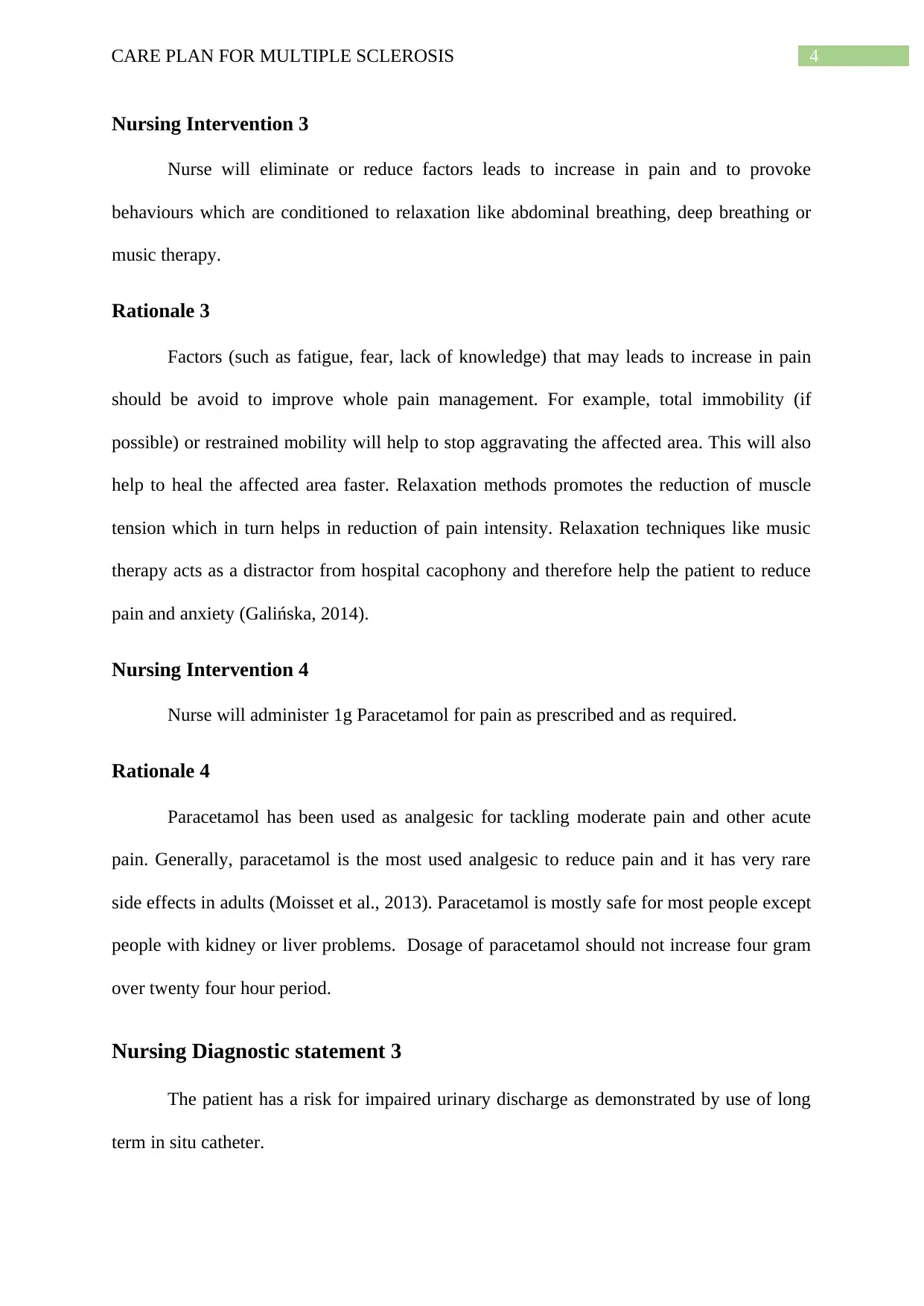
4CARE PLAN FOR MULTIPLE SCLEROSIS
Nursing Intervention 3
Nurse will eliminate or reduce factors leads to increase in pain and to provoke
behaviours which are conditioned to relaxation like abdominal breathing, deep breathing or
music therapy.
Rationale 3
Factors (such as fatigue, fear, lack of knowledge) that may leads to increase in pain
should be avoid to improve whole pain management. For example, total immobility (if
possible) or restrained mobility will help to stop aggravating the affected area. This will also
help to heal the affected area faster. Relaxation methods promotes the reduction of muscle
tension which in turn helps in reduction of pain intensity. Relaxation techniques like music
therapy acts as a distractor from hospital cacophony and therefore help the patient to reduce
pain and anxiety (Galińska, 2014).
Nursing Intervention 4
Nurse will administer 1g Paracetamol for pain as prescribed and as required.
Rationale 4
Paracetamol has been used as analgesic for tackling moderate pain and other acute
pain. Generally, paracetamol is the most used analgesic to reduce pain and it has very rare
side effects in adults (Moisset et al., 2013). Paracetamol is mostly safe for most people except
people with kidney or liver problems. Dosage of paracetamol should not increase four gram
over twenty four hour period.
Nursing Diagnostic statement 3
The patient has a risk for impaired urinary discharge as demonstrated by use of long
term in situ catheter.
Nursing Intervention 3
Nurse will eliminate or reduce factors leads to increase in pain and to provoke
behaviours which are conditioned to relaxation like abdominal breathing, deep breathing or
music therapy.
Rationale 3
Factors (such as fatigue, fear, lack of knowledge) that may leads to increase in pain
should be avoid to improve whole pain management. For example, total immobility (if
possible) or restrained mobility will help to stop aggravating the affected area. This will also
help to heal the affected area faster. Relaxation methods promotes the reduction of muscle
tension which in turn helps in reduction of pain intensity. Relaxation techniques like music
therapy acts as a distractor from hospital cacophony and therefore help the patient to reduce
pain and anxiety (Galińska, 2014).
Nursing Intervention 4
Nurse will administer 1g Paracetamol for pain as prescribed and as required.
Rationale 4
Paracetamol has been used as analgesic for tackling moderate pain and other acute
pain. Generally, paracetamol is the most used analgesic to reduce pain and it has very rare
side effects in adults (Moisset et al., 2013). Paracetamol is mostly safe for most people except
people with kidney or liver problems. Dosage of paracetamol should not increase four gram
over twenty four hour period.
Nursing Diagnostic statement 3
The patient has a risk for impaired urinary discharge as demonstrated by use of long
term in situ catheter.
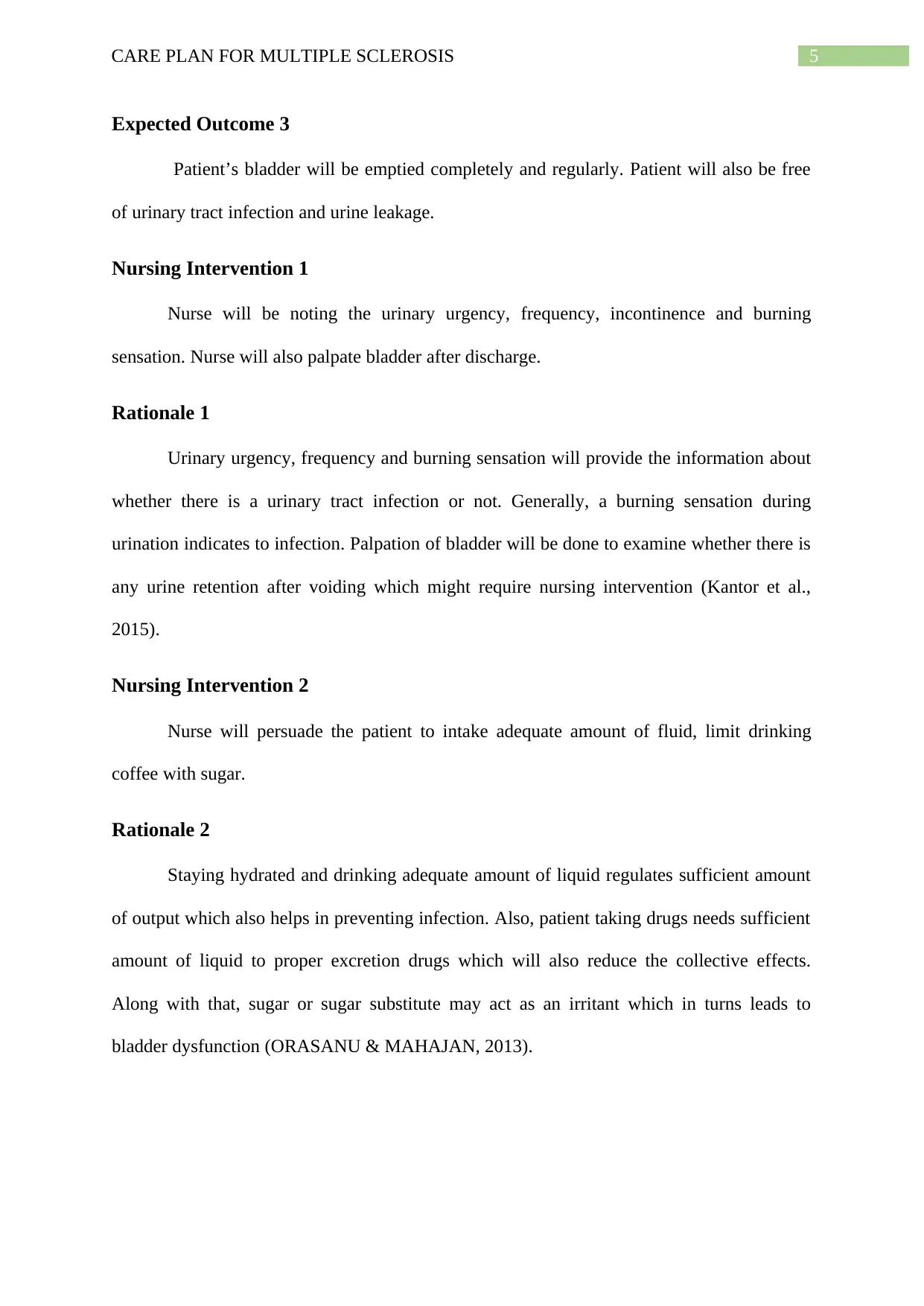
5CARE PLAN FOR MULTIPLE SCLEROSIS
Expected Outcome 3
Patient’s bladder will be emptied completely and regularly. Patient will also be free
of urinary tract infection and urine leakage.
Nursing Intervention 1
Nurse will be noting the urinary urgency, frequency, incontinence and burning
sensation. Nurse will also palpate bladder after discharge.
Rationale 1
Urinary urgency, frequency and burning sensation will provide the information about
whether there is a urinary tract infection or not. Generally, a burning sensation during
urination indicates to infection. Palpation of bladder will be done to examine whether there is
any urine retention after voiding which might require nursing intervention (Kantor et al.,
2015).
Nursing Intervention 2
Nurse will persuade the patient to intake adequate amount of fluid, limit drinking
coffee with sugar.
Rationale 2
Staying hydrated and drinking adequate amount of liquid regulates sufficient amount
of output which also helps in preventing infection. Also, patient taking drugs needs sufficient
amount of liquid to proper excretion drugs which will also reduce the collective effects.
Along with that, sugar or sugar substitute may act as an irritant which in turns leads to
bladder dysfunction (ORASANU & MAHAJAN, 2013).
Expected Outcome 3
Patient’s bladder will be emptied completely and regularly. Patient will also be free
of urinary tract infection and urine leakage.
Nursing Intervention 1
Nurse will be noting the urinary urgency, frequency, incontinence and burning
sensation. Nurse will also palpate bladder after discharge.
Rationale 1
Urinary urgency, frequency and burning sensation will provide the information about
whether there is a urinary tract infection or not. Generally, a burning sensation during
urination indicates to infection. Palpation of bladder will be done to examine whether there is
any urine retention after voiding which might require nursing intervention (Kantor et al.,
2015).
Nursing Intervention 2
Nurse will persuade the patient to intake adequate amount of fluid, limit drinking
coffee with sugar.
Rationale 2
Staying hydrated and drinking adequate amount of liquid regulates sufficient amount
of output which also helps in preventing infection. Also, patient taking drugs needs sufficient
amount of liquid to proper excretion drugs which will also reduce the collective effects.
Along with that, sugar or sugar substitute may act as an irritant which in turns leads to
bladder dysfunction (ORASANU & MAHAJAN, 2013).
⊘ This is a preview!⊘
Do you want full access?
Subscribe today to unlock all pages.

Trusted by 1+ million students worldwide

6CARE PLAN FOR MULTIPLE SCLEROSIS
Nursing Intervention 3
Nurse will administered proper technique and timings of voiding and also recommend
good hygiene procedure.
Rationale 3
Proper timing and voiding technique will help to minimize the incontinence
occurrence as well as diminish the chance of bladder infection or partial emptying of bladder.
It will correspondingly help to restore sufficient functioning of bladder. Proper hygiene
method will lessen the chance of infection as well as reduce coincidental skin irritation (Phé
et al., 2016).
Nursing Intervention 4
Nurse will supervise the consumption of 10 mg Ditropan oral tablet as prescribed and
as required.
Rationale 4
Ditropan belongs to the Oxybutynin groups. The medicine Oxybutynin works to
lessen the symptoms of a hyperactive bladder like leakage, urinary frequency and urinary
urgency. Working mechanism of this medication is to relax the bladder muscles which lead to
lessening of the urge to urination, bladder spasms and urination frequency (Adamec &
Habek, 2013). It might be harmful to the patients if it is not prescribed by medical
practitioner.
Nursing Diagnostic Statement 4
Patient has a risk for self-care insufficiency as demonstrated by the patient’s need of
assistance in mobility and maintaining personal hygiene like showering.
Nursing Intervention 3
Nurse will administered proper technique and timings of voiding and also recommend
good hygiene procedure.
Rationale 3
Proper timing and voiding technique will help to minimize the incontinence
occurrence as well as diminish the chance of bladder infection or partial emptying of bladder.
It will correspondingly help to restore sufficient functioning of bladder. Proper hygiene
method will lessen the chance of infection as well as reduce coincidental skin irritation (Phé
et al., 2016).
Nursing Intervention 4
Nurse will supervise the consumption of 10 mg Ditropan oral tablet as prescribed and
as required.
Rationale 4
Ditropan belongs to the Oxybutynin groups. The medicine Oxybutynin works to
lessen the symptoms of a hyperactive bladder like leakage, urinary frequency and urinary
urgency. Working mechanism of this medication is to relax the bladder muscles which lead to
lessening of the urge to urination, bladder spasms and urination frequency (Adamec &
Habek, 2013). It might be harmful to the patients if it is not prescribed by medical
practitioner.
Nursing Diagnostic Statement 4
Patient has a risk for self-care insufficiency as demonstrated by the patient’s need of
assistance in mobility and maintaining personal hygiene like showering.
Paraphrase This Document
Need a fresh take? Get an instant paraphrase of this document with our AI Paraphraser
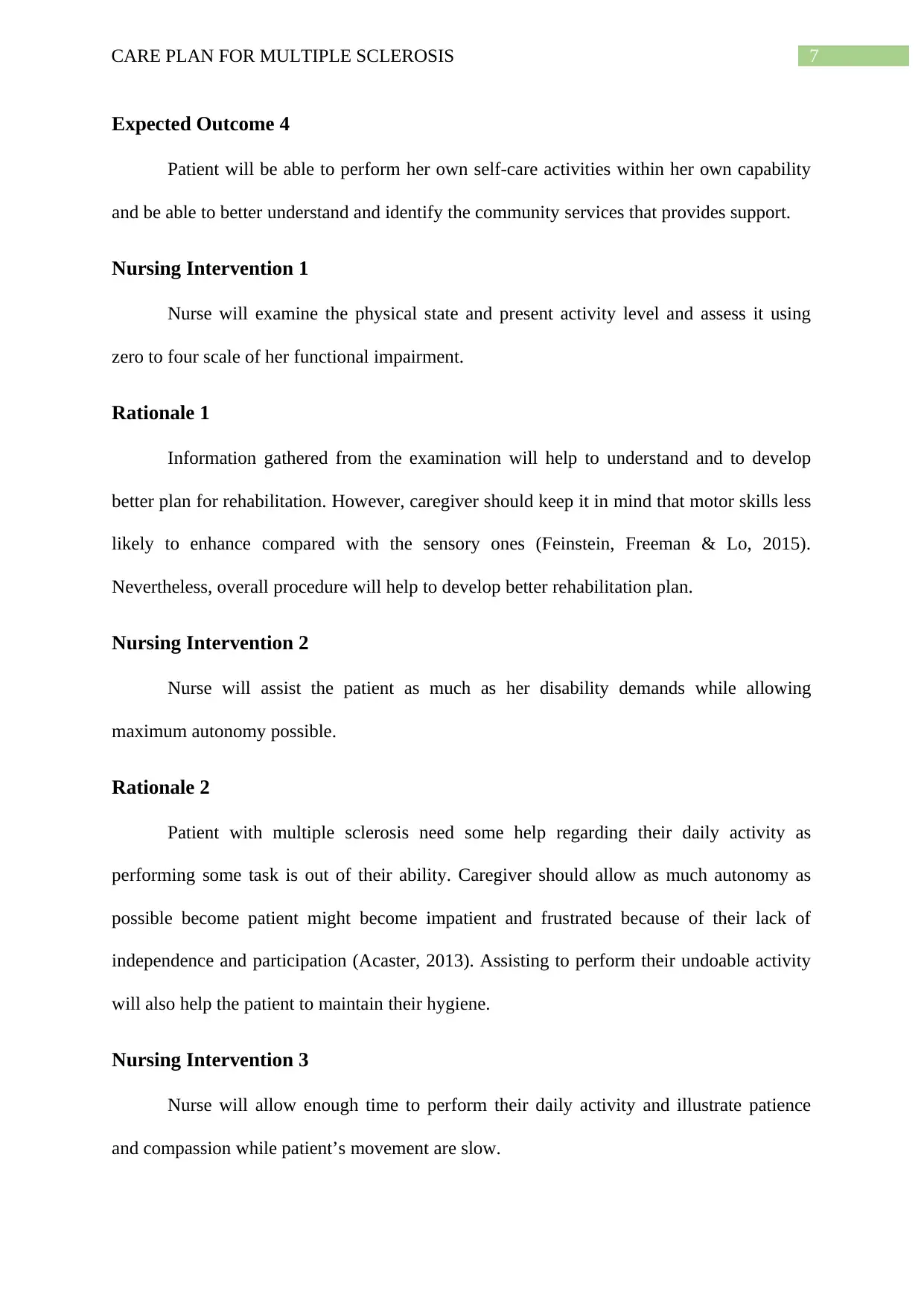
7CARE PLAN FOR MULTIPLE SCLEROSIS
Expected Outcome 4
Patient will be able to perform her own self-care activities within her own capability
and be able to better understand and identify the community services that provides support.
Nursing Intervention 1
Nurse will examine the physical state and present activity level and assess it using
zero to four scale of her functional impairment.
Rationale 1
Information gathered from the examination will help to understand and to develop
better plan for rehabilitation. However, caregiver should keep it in mind that motor skills less
likely to enhance compared with the sensory ones (Feinstein, Freeman & Lo, 2015).
Nevertheless, overall procedure will help to develop better rehabilitation plan.
Nursing Intervention 2
Nurse will assist the patient as much as her disability demands while allowing
maximum autonomy possible.
Rationale 2
Patient with multiple sclerosis need some help regarding their daily activity as
performing some task is out of their ability. Caregiver should allow as much autonomy as
possible become patient might become impatient and frustrated because of their lack of
independence and participation (Acaster, 2013). Assisting to perform their undoable activity
will also help the patient to maintain their hygiene.
Nursing Intervention 3
Nurse will allow enough time to perform their daily activity and illustrate patience
and compassion while patient’s movement are slow.
Expected Outcome 4
Patient will be able to perform her own self-care activities within her own capability
and be able to better understand and identify the community services that provides support.
Nursing Intervention 1
Nurse will examine the physical state and present activity level and assess it using
zero to four scale of her functional impairment.
Rationale 1
Information gathered from the examination will help to understand and to develop
better plan for rehabilitation. However, caregiver should keep it in mind that motor skills less
likely to enhance compared with the sensory ones (Feinstein, Freeman & Lo, 2015).
Nevertheless, overall procedure will help to develop better rehabilitation plan.
Nursing Intervention 2
Nurse will assist the patient as much as her disability demands while allowing
maximum autonomy possible.
Rationale 2
Patient with multiple sclerosis need some help regarding their daily activity as
performing some task is out of their ability. Caregiver should allow as much autonomy as
possible become patient might become impatient and frustrated because of their lack of
independence and participation (Acaster, 2013). Assisting to perform their undoable activity
will also help the patient to maintain their hygiene.
Nursing Intervention 3
Nurse will allow enough time to perform their daily activity and illustrate patience
and compassion while patient’s movement are slow.
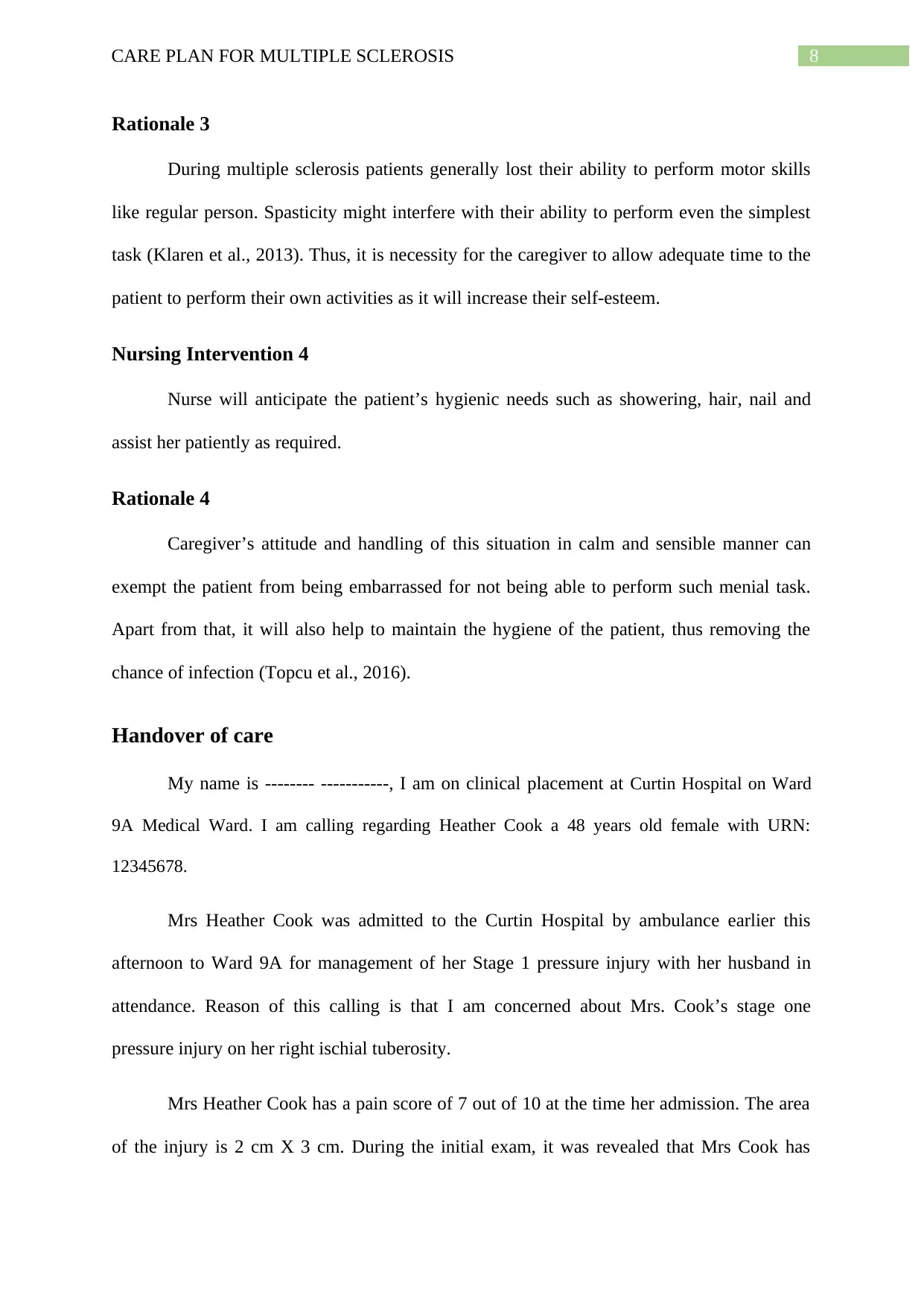
8CARE PLAN FOR MULTIPLE SCLEROSIS
Rationale 3
During multiple sclerosis patients generally lost their ability to perform motor skills
like regular person. Spasticity might interfere with their ability to perform even the simplest
task (Klaren et al., 2013). Thus, it is necessity for the caregiver to allow adequate time to the
patient to perform their own activities as it will increase their self-esteem.
Nursing Intervention 4
Nurse will anticipate the patient’s hygienic needs such as showering, hair, nail and
assist her patiently as required.
Rationale 4
Caregiver’s attitude and handling of this situation in calm and sensible manner can
exempt the patient from being embarrassed for not being able to perform such menial task.
Apart from that, it will also help to maintain the hygiene of the patient, thus removing the
chance of infection (Topcu et al., 2016).
Handover of care
My name is -------- -----------, I am on clinical placement at Curtin Hospital on Ward
9A Medical Ward. I am calling regarding Heather Cook a 48 years old female with URN:
12345678.
Mrs Heather Cook was admitted to the Curtin Hospital by ambulance earlier this
afternoon to Ward 9A for management of her Stage 1 pressure injury with her husband in
attendance. Reason of this calling is that I am concerned about Mrs. Cook’s stage one
pressure injury on her right ischial tuberosity.
Mrs Heather Cook has a pain score of 7 out of 10 at the time her admission. The area
of the injury is 2 cm X 3 cm. During the initial exam, it was revealed that Mrs Cook has
Rationale 3
During multiple sclerosis patients generally lost their ability to perform motor skills
like regular person. Spasticity might interfere with their ability to perform even the simplest
task (Klaren et al., 2013). Thus, it is necessity for the caregiver to allow adequate time to the
patient to perform their own activities as it will increase their self-esteem.
Nursing Intervention 4
Nurse will anticipate the patient’s hygienic needs such as showering, hair, nail and
assist her patiently as required.
Rationale 4
Caregiver’s attitude and handling of this situation in calm and sensible manner can
exempt the patient from being embarrassed for not being able to perform such menial task.
Apart from that, it will also help to maintain the hygiene of the patient, thus removing the
chance of infection (Topcu et al., 2016).
Handover of care
My name is -------- -----------, I am on clinical placement at Curtin Hospital on Ward
9A Medical Ward. I am calling regarding Heather Cook a 48 years old female with URN:
12345678.
Mrs Heather Cook was admitted to the Curtin Hospital by ambulance earlier this
afternoon to Ward 9A for management of her Stage 1 pressure injury with her husband in
attendance. Reason of this calling is that I am concerned about Mrs. Cook’s stage one
pressure injury on her right ischial tuberosity.
Mrs Heather Cook has a pain score of 7 out of 10 at the time her admission. The area
of the injury is 2 cm X 3 cm. During the initial exam, it was revealed that Mrs Cook has
⊘ This is a preview!⊘
Do you want full access?
Subscribe today to unlock all pages.

Trusted by 1+ million students worldwide
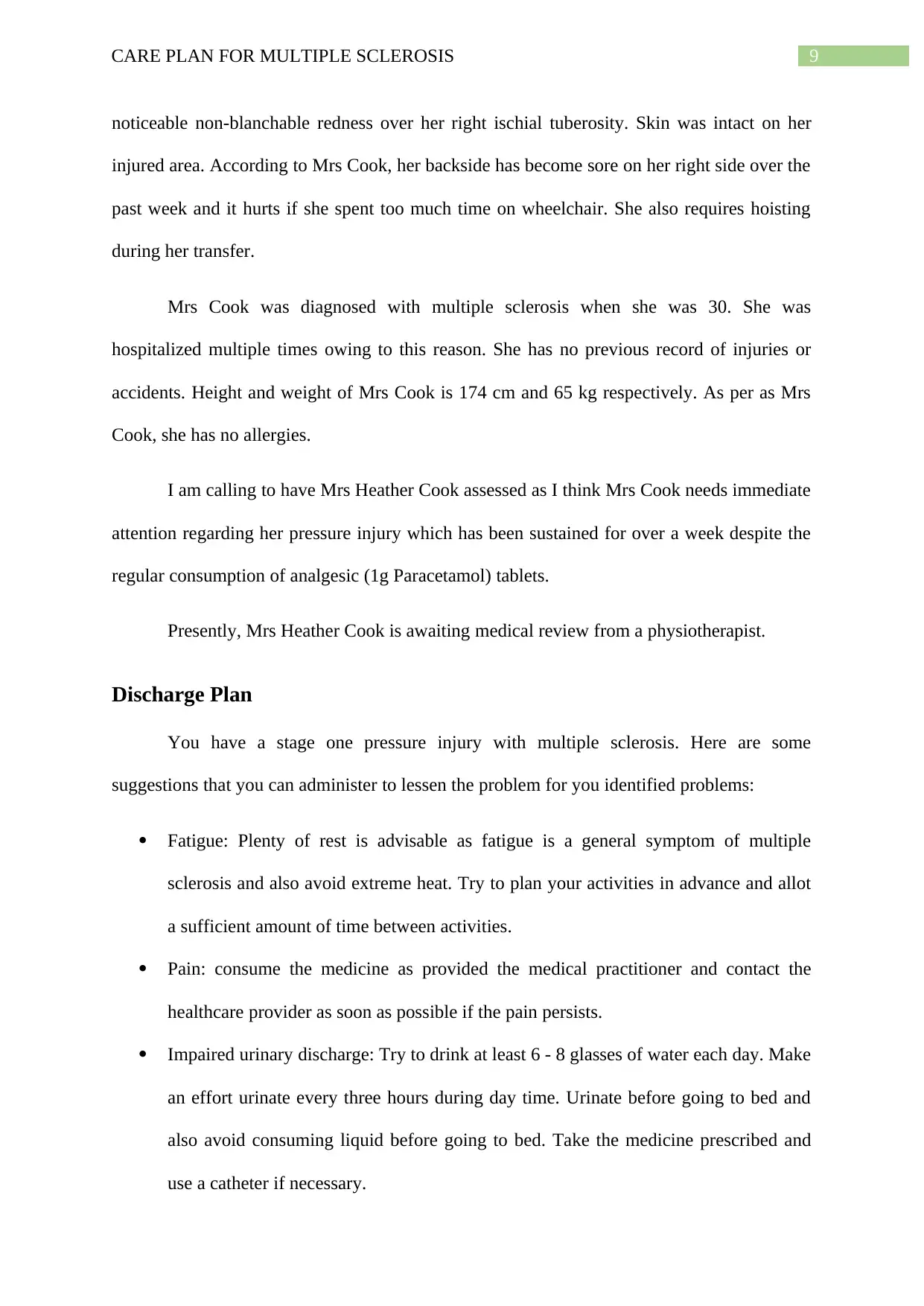
9CARE PLAN FOR MULTIPLE SCLEROSIS
noticeable non-blanchable redness over her right ischial tuberosity. Skin was intact on her
injured area. According to Mrs Cook, her backside has become sore on her right side over the
past week and it hurts if she spent too much time on wheelchair. She also requires hoisting
during her transfer.
Mrs Cook was diagnosed with multiple sclerosis when she was 30. She was
hospitalized multiple times owing to this reason. She has no previous record of injuries or
accidents. Height and weight of Mrs Cook is 174 cm and 65 kg respectively. As per as Mrs
Cook, she has no allergies.
I am calling to have Mrs Heather Cook assessed as I think Mrs Cook needs immediate
attention regarding her pressure injury which has been sustained for over a week despite the
regular consumption of analgesic (1g Paracetamol) tablets.
Presently, Mrs Heather Cook is awaiting medical review from a physiotherapist.
Discharge Plan
You have a stage one pressure injury with multiple sclerosis. Here are some
suggestions that you can administer to lessen the problem for you identified problems:
Fatigue: Plenty of rest is advisable as fatigue is a general symptom of multiple
sclerosis and also avoid extreme heat. Try to plan your activities in advance and allot
a sufficient amount of time between activities.
Pain: consume the medicine as provided the medical practitioner and contact the
healthcare provider as soon as possible if the pain persists.
Impaired urinary discharge: Try to drink at least 6 - 8 glasses of water each day. Make
an effort urinate every three hours during day time. Urinate before going to bed and
also avoid consuming liquid before going to bed. Take the medicine prescribed and
use a catheter if necessary.
noticeable non-blanchable redness over her right ischial tuberosity. Skin was intact on her
injured area. According to Mrs Cook, her backside has become sore on her right side over the
past week and it hurts if she spent too much time on wheelchair. She also requires hoisting
during her transfer.
Mrs Cook was diagnosed with multiple sclerosis when she was 30. She was
hospitalized multiple times owing to this reason. She has no previous record of injuries or
accidents. Height and weight of Mrs Cook is 174 cm and 65 kg respectively. As per as Mrs
Cook, she has no allergies.
I am calling to have Mrs Heather Cook assessed as I think Mrs Cook needs immediate
attention regarding her pressure injury which has been sustained for over a week despite the
regular consumption of analgesic (1g Paracetamol) tablets.
Presently, Mrs Heather Cook is awaiting medical review from a physiotherapist.
Discharge Plan
You have a stage one pressure injury with multiple sclerosis. Here are some
suggestions that you can administer to lessen the problem for you identified problems:
Fatigue: Plenty of rest is advisable as fatigue is a general symptom of multiple
sclerosis and also avoid extreme heat. Try to plan your activities in advance and allot
a sufficient amount of time between activities.
Pain: consume the medicine as provided the medical practitioner and contact the
healthcare provider as soon as possible if the pain persists.
Impaired urinary discharge: Try to drink at least 6 - 8 glasses of water each day. Make
an effort urinate every three hours during day time. Urinate before going to bed and
also avoid consuming liquid before going to bed. Take the medicine prescribed and
use a catheter if necessary.
Paraphrase This Document
Need a fresh take? Get an instant paraphrase of this document with our AI Paraphraser

10CARE PLAN FOR MULTIPLE SCLEROSIS
Self-care deficit: to manage your stress level performs the activities that relaxes you.
Get in touch with local community and support centre if support from family member
is not sufficient.
Along with the above, please do not hesitate or delay to call the healthcare provider if any of
these symptoms occurs: high fever, extreme weakness or tiredness, vision impairment or
unusual or confusing behaviour.
Self-care deficit: to manage your stress level performs the activities that relaxes you.
Get in touch with local community and support centre if support from family member
is not sufficient.
Along with the above, please do not hesitate or delay to call the healthcare provider if any of
these symptoms occurs: high fever, extreme weakness or tiredness, vision impairment or
unusual or confusing behaviour.
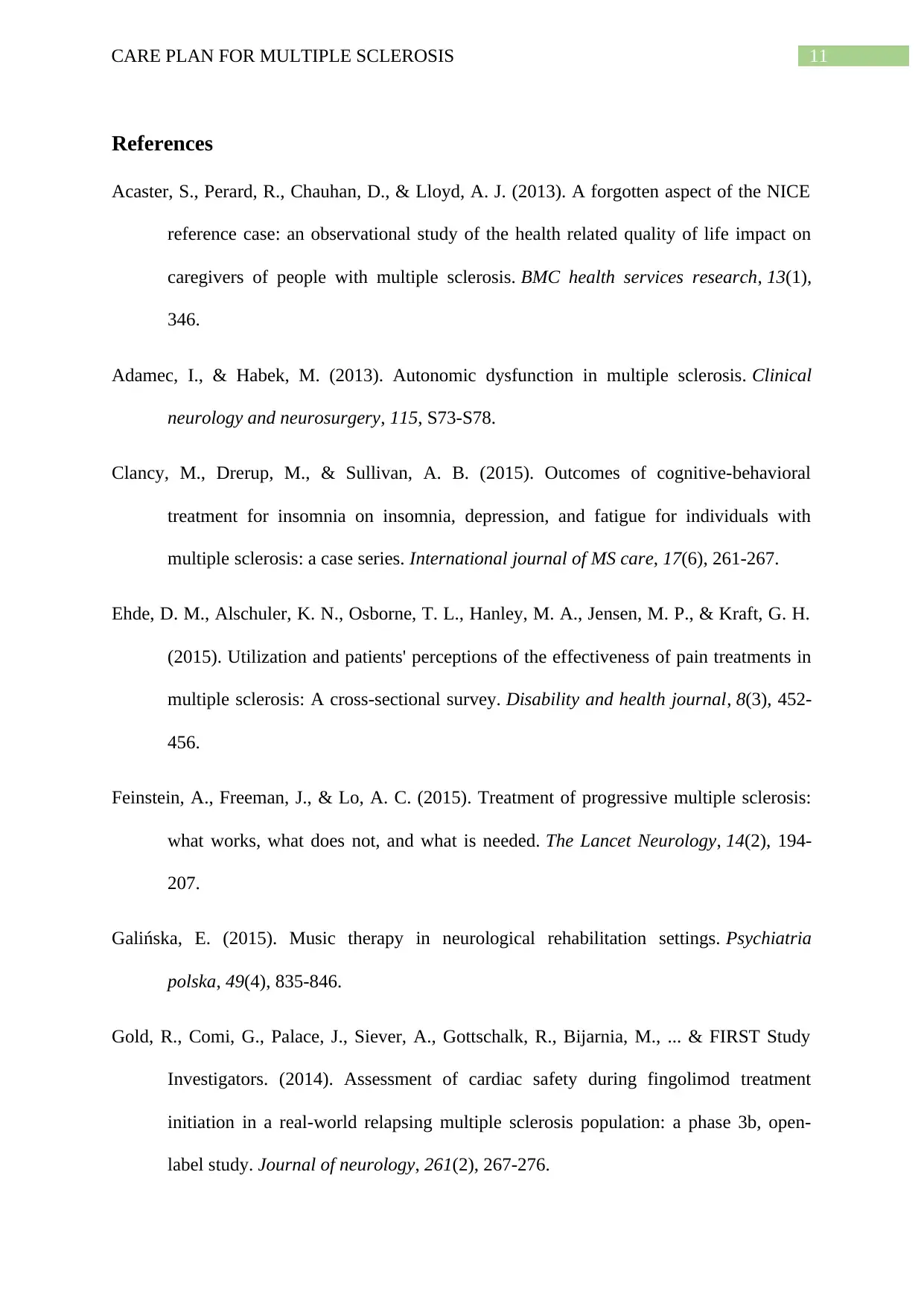
11CARE PLAN FOR MULTIPLE SCLEROSIS
References
Acaster, S., Perard, R., Chauhan, D., & Lloyd, A. J. (2013). A forgotten aspect of the NICE
reference case: an observational study of the health related quality of life impact on
caregivers of people with multiple sclerosis. BMC health services research, 13(1),
346.
Adamec, I., & Habek, M. (2013). Autonomic dysfunction in multiple sclerosis. Clinical
neurology and neurosurgery, 115, S73-S78.
Clancy, M., Drerup, M., & Sullivan, A. B. (2015). Outcomes of cognitive-behavioral
treatment for insomnia on insomnia, depression, and fatigue for individuals with
multiple sclerosis: a case series. International journal of MS care, 17(6), 261-267.
Ehde, D. M., Alschuler, K. N., Osborne, T. L., Hanley, M. A., Jensen, M. P., & Kraft, G. H.
(2015). Utilization and patients' perceptions of the effectiveness of pain treatments in
multiple sclerosis: A cross-sectional survey. Disability and health journal, 8(3), 452-
456.
Feinstein, A., Freeman, J., & Lo, A. C. (2015). Treatment of progressive multiple sclerosis:
what works, what does not, and what is needed. The Lancet Neurology, 14(2), 194-
207.
Galińska, E. (2015). Music therapy in neurological rehabilitation settings. Psychiatria
polska, 49(4), 835-846.
Gold, R., Comi, G., Palace, J., Siever, A., Gottschalk, R., Bijarnia, M., ... & FIRST Study
Investigators. (2014). Assessment of cardiac safety during fingolimod treatment
initiation in a real-world relapsing multiple sclerosis population: a phase 3b, open-
label study. Journal of neurology, 261(2), 267-276.
References
Acaster, S., Perard, R., Chauhan, D., & Lloyd, A. J. (2013). A forgotten aspect of the NICE
reference case: an observational study of the health related quality of life impact on
caregivers of people with multiple sclerosis. BMC health services research, 13(1),
346.
Adamec, I., & Habek, M. (2013). Autonomic dysfunction in multiple sclerosis. Clinical
neurology and neurosurgery, 115, S73-S78.
Clancy, M., Drerup, M., & Sullivan, A. B. (2015). Outcomes of cognitive-behavioral
treatment for insomnia on insomnia, depression, and fatigue for individuals with
multiple sclerosis: a case series. International journal of MS care, 17(6), 261-267.
Ehde, D. M., Alschuler, K. N., Osborne, T. L., Hanley, M. A., Jensen, M. P., & Kraft, G. H.
(2015). Utilization and patients' perceptions of the effectiveness of pain treatments in
multiple sclerosis: A cross-sectional survey. Disability and health journal, 8(3), 452-
456.
Feinstein, A., Freeman, J., & Lo, A. C. (2015). Treatment of progressive multiple sclerosis:
what works, what does not, and what is needed. The Lancet Neurology, 14(2), 194-
207.
Galińska, E. (2015). Music therapy in neurological rehabilitation settings. Psychiatria
polska, 49(4), 835-846.
Gold, R., Comi, G., Palace, J., Siever, A., Gottschalk, R., Bijarnia, M., ... & FIRST Study
Investigators. (2014). Assessment of cardiac safety during fingolimod treatment
initiation in a real-world relapsing multiple sclerosis population: a phase 3b, open-
label study. Journal of neurology, 261(2), 267-276.
⊘ This is a preview!⊘
Do you want full access?
Subscribe today to unlock all pages.

Trusted by 1+ million students worldwide
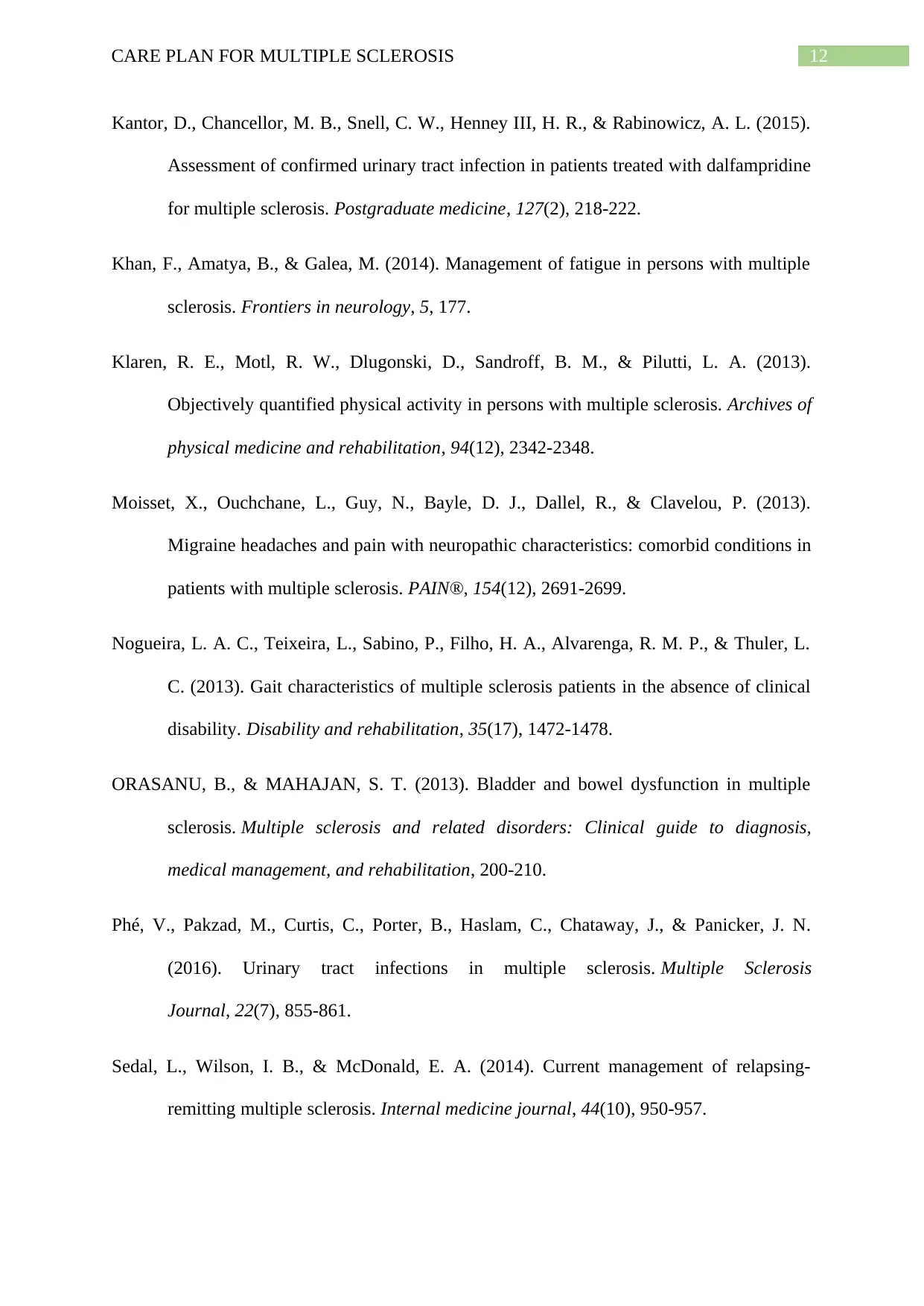
12CARE PLAN FOR MULTIPLE SCLEROSIS
Kantor, D., Chancellor, M. B., Snell, C. W., Henney III, H. R., & Rabinowicz, A. L. (2015).
Assessment of confirmed urinary tract infection in patients treated with dalfampridine
for multiple sclerosis. Postgraduate medicine, 127(2), 218-222.
Khan, F., Amatya, B., & Galea, M. (2014). Management of fatigue in persons with multiple
sclerosis. Frontiers in neurology, 5, 177.
Klaren, R. E., Motl, R. W., Dlugonski, D., Sandroff, B. M., & Pilutti, L. A. (2013).
Objectively quantified physical activity in persons with multiple sclerosis. Archives of
physical medicine and rehabilitation, 94(12), 2342-2348.
Moisset, X., Ouchchane, L., Guy, N., Bayle, D. J., Dallel, R., & Clavelou, P. (2013).
Migraine headaches and pain with neuropathic characteristics: comorbid conditions in
patients with multiple sclerosis. PAIN®, 154(12), 2691-2699.
Nogueira, L. A. C., Teixeira, L., Sabino, P., Filho, H. A., Alvarenga, R. M. P., & Thuler, L.
C. (2013). Gait characteristics of multiple sclerosis patients in the absence of clinical
disability. Disability and rehabilitation, 35(17), 1472-1478.
ORASANU, B., & MAHAJAN, S. T. (2013). Bladder and bowel dysfunction in multiple
sclerosis. Multiple sclerosis and related disorders: Clinical guide to diagnosis,
medical management, and rehabilitation, 200-210.
Phé, V., Pakzad, M., Curtis, C., Porter, B., Haslam, C., Chataway, J., & Panicker, J. N.
(2016). Urinary tract infections in multiple sclerosis. Multiple Sclerosis
Journal, 22(7), 855-861.
Sedal, L., Wilson, I. B., & McDonald, E. A. (2014). Current management of relapsing‐
remitting multiple sclerosis. Internal medicine journal, 44(10), 950-957.
Kantor, D., Chancellor, M. B., Snell, C. W., Henney III, H. R., & Rabinowicz, A. L. (2015).
Assessment of confirmed urinary tract infection in patients treated with dalfampridine
for multiple sclerosis. Postgraduate medicine, 127(2), 218-222.
Khan, F., Amatya, B., & Galea, M. (2014). Management of fatigue in persons with multiple
sclerosis. Frontiers in neurology, 5, 177.
Klaren, R. E., Motl, R. W., Dlugonski, D., Sandroff, B. M., & Pilutti, L. A. (2013).
Objectively quantified physical activity in persons with multiple sclerosis. Archives of
physical medicine and rehabilitation, 94(12), 2342-2348.
Moisset, X., Ouchchane, L., Guy, N., Bayle, D. J., Dallel, R., & Clavelou, P. (2013).
Migraine headaches and pain with neuropathic characteristics: comorbid conditions in
patients with multiple sclerosis. PAIN®, 154(12), 2691-2699.
Nogueira, L. A. C., Teixeira, L., Sabino, P., Filho, H. A., Alvarenga, R. M. P., & Thuler, L.
C. (2013). Gait characteristics of multiple sclerosis patients in the absence of clinical
disability. Disability and rehabilitation, 35(17), 1472-1478.
ORASANU, B., & MAHAJAN, S. T. (2013). Bladder and bowel dysfunction in multiple
sclerosis. Multiple sclerosis and related disorders: Clinical guide to diagnosis,
medical management, and rehabilitation, 200-210.
Phé, V., Pakzad, M., Curtis, C., Porter, B., Haslam, C., Chataway, J., & Panicker, J. N.
(2016). Urinary tract infections in multiple sclerosis. Multiple Sclerosis
Journal, 22(7), 855-861.
Sedal, L., Wilson, I. B., & McDonald, E. A. (2014). Current management of relapsing‐
remitting multiple sclerosis. Internal medicine journal, 44(10), 950-957.
Paraphrase This Document
Need a fresh take? Get an instant paraphrase of this document with our AI Paraphraser

13CARE PLAN FOR MULTIPLE SCLEROSIS
Topcu, G., Buchanan, H., Aubeeluck, A., & Garip, G. (2016). Caregiving in multiple
sclerosis and quality of life: A meta-synthesis of qualitative research. Psychology &
health, 31(6), 693-710.
Topcu, G., Buchanan, H., Aubeeluck, A., & Garip, G. (2016). Caregiving in multiple
sclerosis and quality of life: A meta-synthesis of qualitative research. Psychology &
health, 31(6), 693-710.
1 out of 14
Related Documents
Your All-in-One AI-Powered Toolkit for Academic Success.
+13062052269
info@desklib.com
Available 24*7 on WhatsApp / Email
![[object Object]](/_next/static/media/star-bottom.7253800d.svg)
Unlock your academic potential
© 2024 | Zucol Services PVT LTD | All rights reserved.



